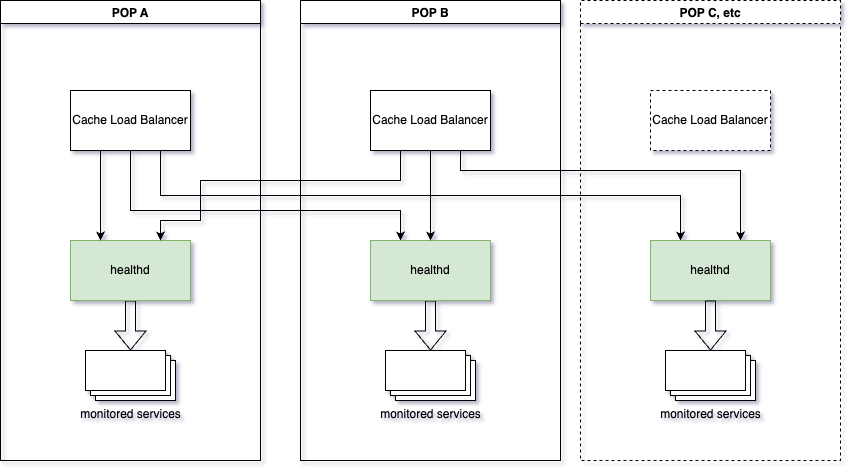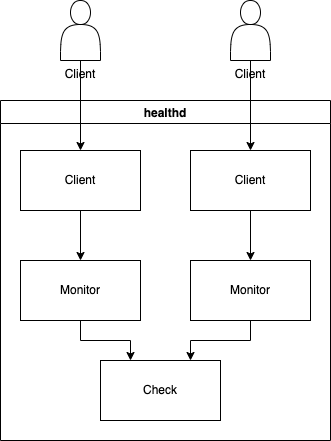legacy code rewrite
Disclaimer:
This is a story about successfully rewriting some fairly simple legacy software.
Your legacy software is likely not as simple to rewrite.
You should not rewrite your legacy software.
What is legacy software?
Legacy software is:
- something written long ago, maybe by someone else
- likely to be earning revenue right now
- written in some outdated programming language with the techniques of the time, without tests
- likely to have awkward parts added on over time, some done in haste under time pressure
My Legacy Codebase
At my last employer there was a server health monitoring system called healthd.
healthd was a heap of inheritance-based C++ that had been in operation at the company for 17 years.
Its source code was intermingled with other code implementing another obsolete service.
It had a few quirks but did the job most of the time.
As part of a larger effort to decommission hundreds of aging physical FreeBSD servers, I needed to move the healthd service to different servers.
The available servers were running Ubuntu Linux.
I hoped it would be an easy task: create a GitLab CI job to build and package the existing code for Ubuntu, then create a little Saltstack code to deploy it.
The port was easy, but testing found that some quirks seemed to be exacerbated and there was growth in memory usage suggestive of a leak. On top of that, for years the company had been putting up with one intermittent failure mode that had recently caused another major issue. This meant that there was finally some support for making changes to fix the failure mode. Should I be the one to brave the legacy code change?
The Rewrite
If I was going to fix these issues then I either had to re-learn how to debug/profile C++ and patch the issues or rewrite the system in Go. I have decades of experience with legacy software. That experience leads me to strongly prefer the former option. Sometimes though, the best option is a fresh start, which proved to be the case for this project.
Code Structure
This was the perfect application for Go. I expected that a Go implementation would likely take very little time to write and would allow solving the behavior issues while also drastically improving maintainability.
healthd is a distributed server health monitoring system.
Instances are run within all datacenter and monitor servers within that datacenter.

Clients in other datacenters connect to a local instance and request a monitor of a target local server.
One or more monitors is satisfied by a check, which periodically confirms the proper operation of the target.
These user-concepts map well to Go structs an goroutines make the code easy to write and to understand.
These comprise the architecture of healthd along with an additional component to manage the client socket and interface.
This diagram shows their relationship:

When a client connects, a new client goroutine is created listening for commands.
The monitor command creates a monitor which links the client’s request to the one unique check which is created when a target is first monitored.
Each check is a goroutine that performs the monitoring, notifies the attached monitors, then sleeps for the required monitoring interval.
Outcome
As a result of this rewrite I was able to resolve bugs, put the code under test, and simplify the codebase by implementing it in Go.
As measured by cloc, the C++ code was almost 4000 lines of untested inheritance-based legacy.
[mikezuff@macbook legacy-healthd]$ cloc $LEGACY_FILES
31 text files.
31 unique files.
0 files ignored.
github.com/AlDanial/cloc v 2.02 T=0.03 s (1167.7 files/s, 179480.4 lines/s)
-------------------------------------------------------------------------------
Language files blank comment code
-------------------------------------------------------------------------------
C++ 19 578 229 3250
C/C++ Header 12 150 26 532
-------------------------------------------------------------------------------
SUM: 31 728 255 3782
-------------------------------------------------------------------------------
The Go code is 2300 lines of modern, tested, maintainable code. Writing this code in a test-first style guided the implementation and resulted in solid test coverage.
[mikezuff@macbook go-healthd]$ cloc $GO_FILES
20 text files.
20 unique files.
0 files ignored.
github.com/AlDanial/cloc v 2.02 T=0.03 s (589.3 files/s, 78557.4 lines/s)
-------------------------------------------------------------------------------
Language files blank comment code
-------------------------------------------------------------------------------
Go 16 297 93 2240
Text 4 2 0 34
-------------------------------------------------------------------------------
SUM: 20 299 93 2274
-------------------------------------------------------------------------------
I call that a win.
